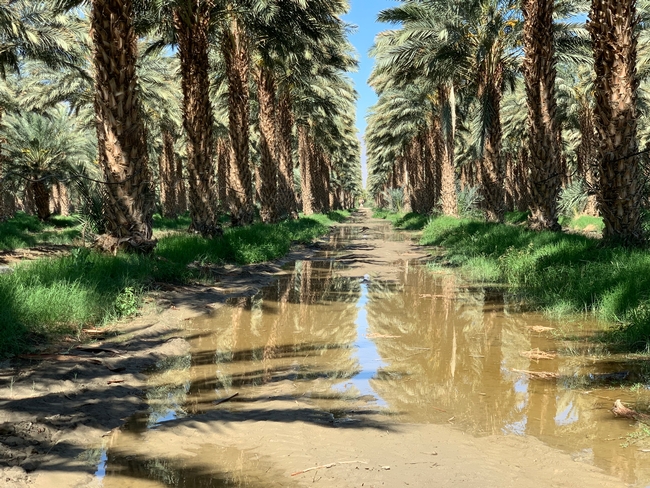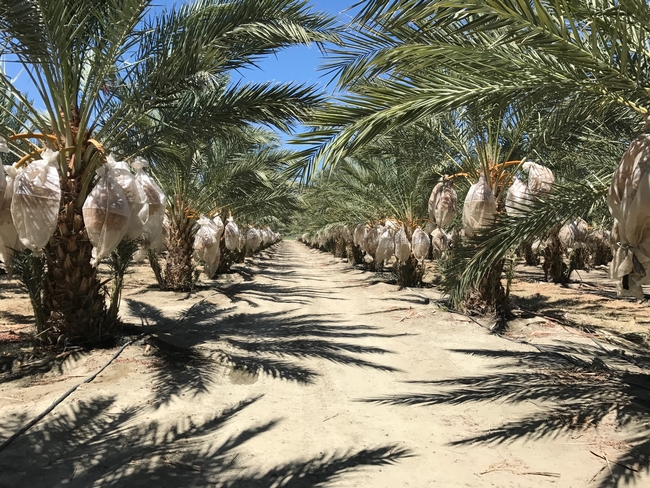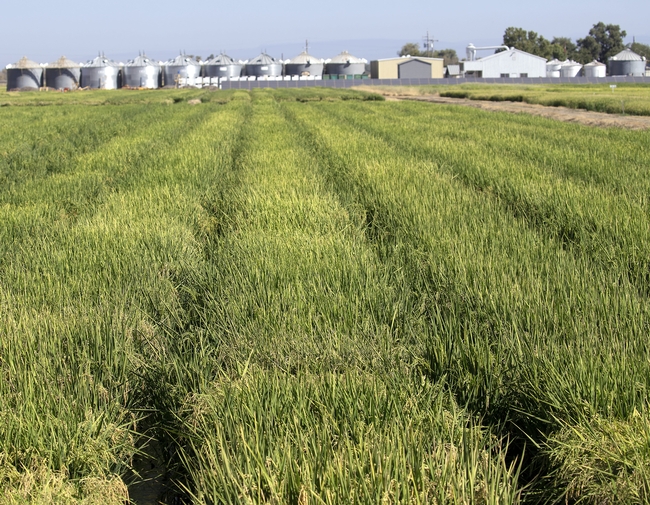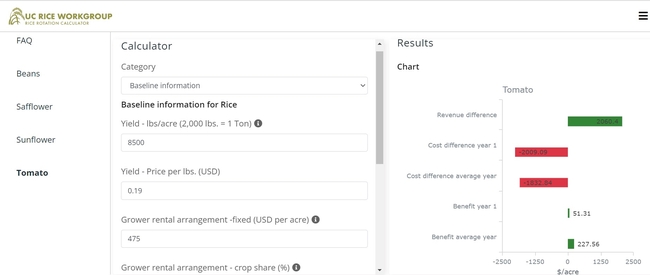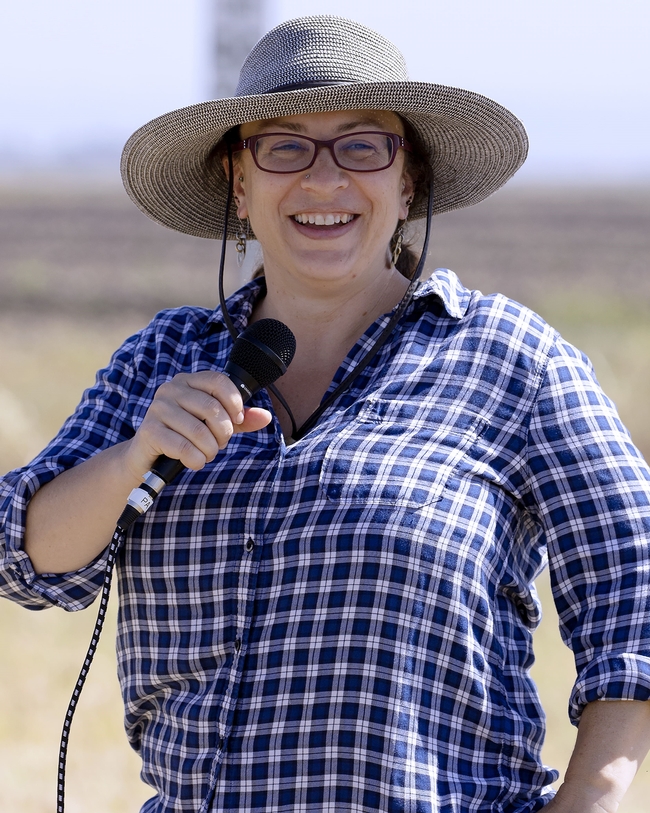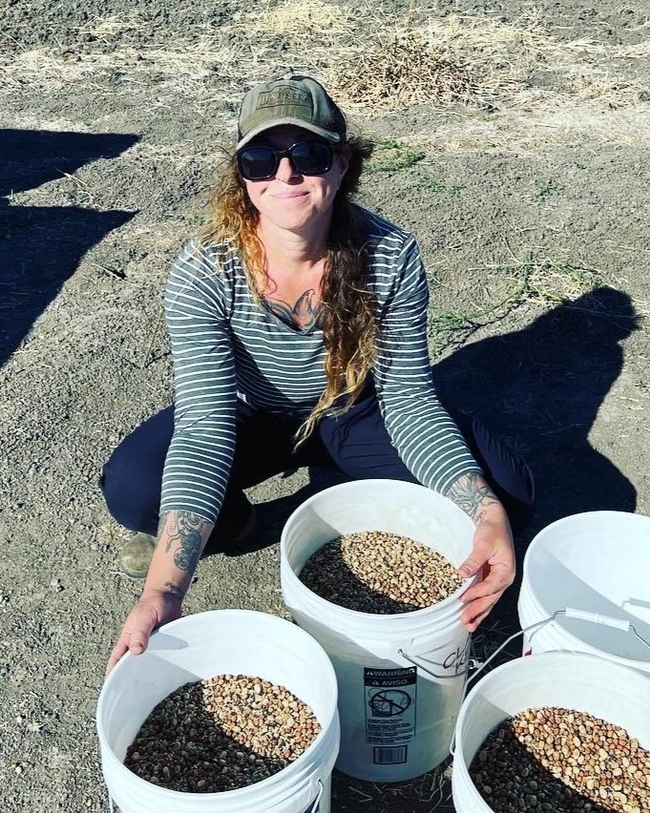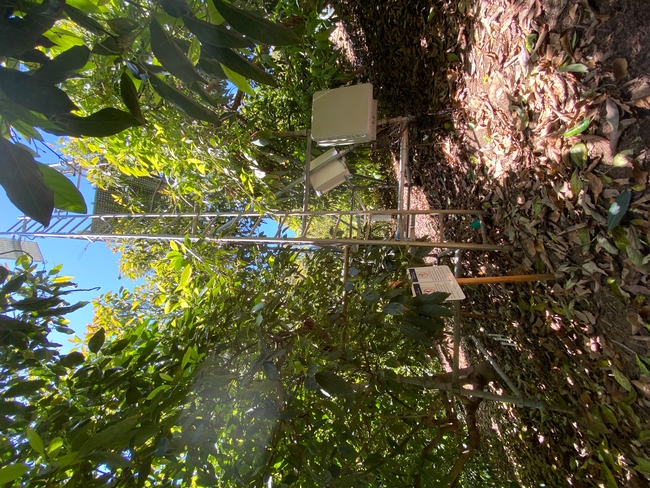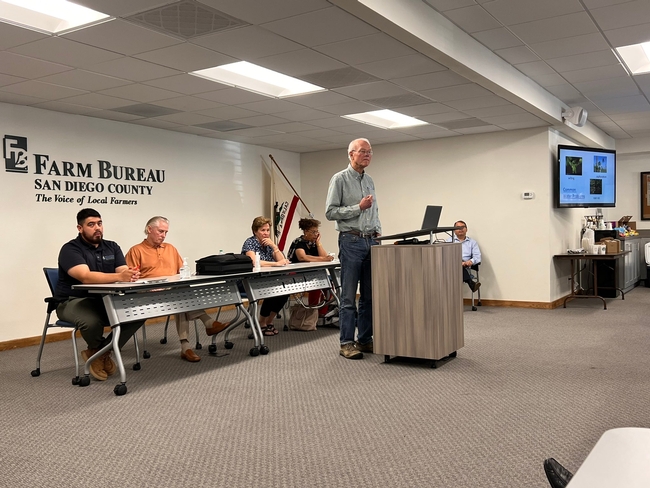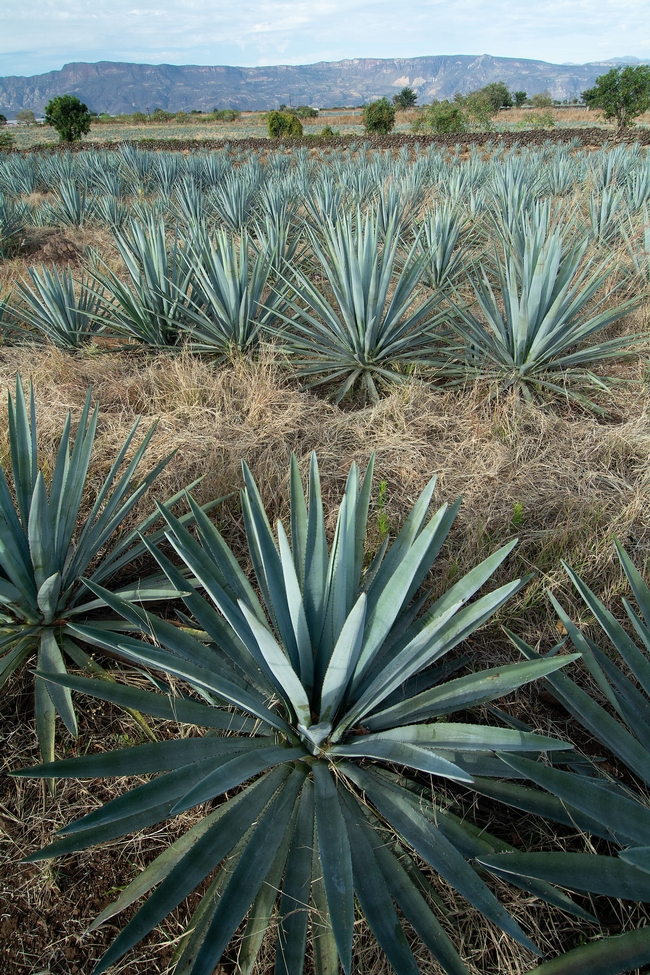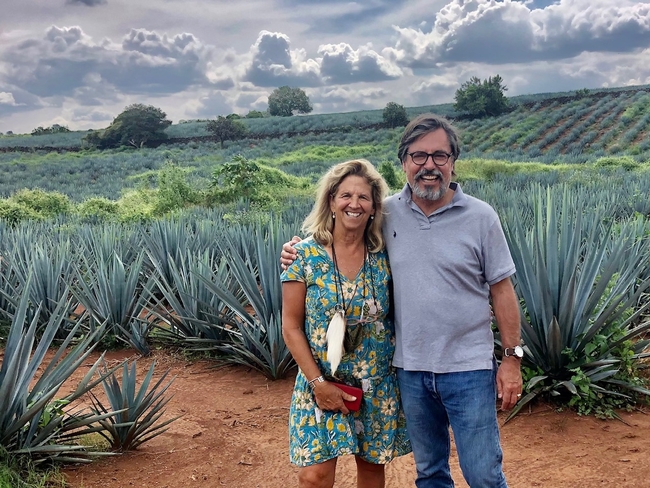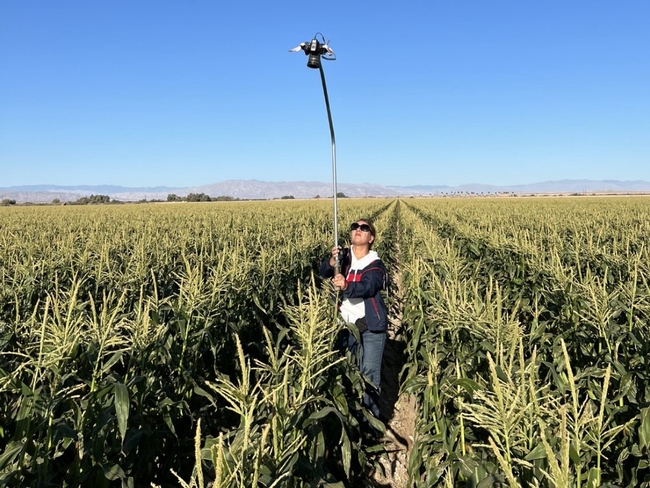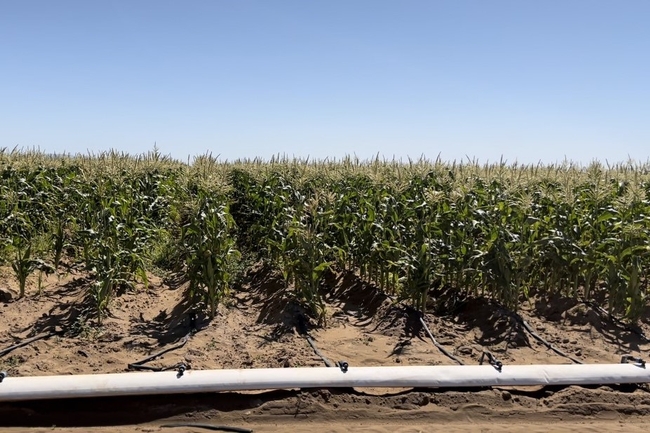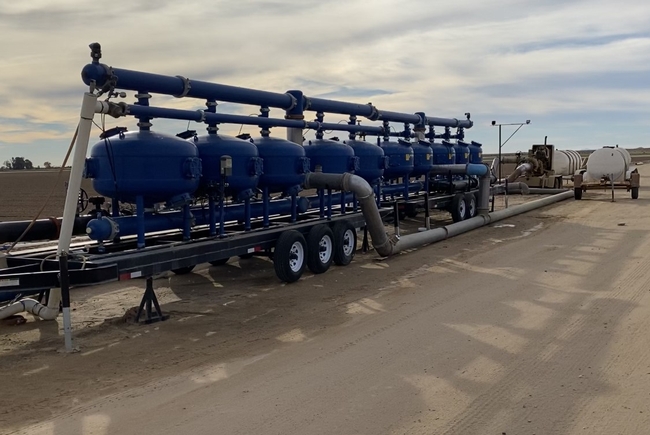Posts Tagged: water
Date palm irrigation research provides economic, environmental benefits
Historically, date palms are grown along riverbeds or in areas with groundwater because they require an abundance of water to produce a good crop. Unlike lettuce or table grapes, date palms are deceptive in that they do not immediately wilt if underwatered. Eventually, however, the lack of water hurts yields and fruit quality.
The default for date growers is to apply excessive water, but doing so is neither economically nor environmentally sound. To help growers, Ali Montazar, UC Cooperative Extension irrigation and water management advisor for Imperial, Riverside and San Diego counties, has developed knowledge that enables growers in the region to establish irrigation guidelines they can use with confidence.
“Water issues in California's desert are very different than in the Central Valley,” said Montazar. “There is no groundwater to recharge so growers in the desert only have the Colorado River.”
Since 2019, Montazar has been focused on irrigation management for date palms in the Coachella Valley, the largest producer of dates in the United States. Montazar's research identifies how much water is needed for the crop and the best water delivery method according to location, soil type and conditions, and date cultivars.
“Dates require a lot of heat and light, which is why they do well in the desert. But they also need a fair amount of irrigation,” said Robert Krueger, a U.S. Department of Agriculture horticulturist and Montazar's co-author of a paper on date palm irrigation management.
Much of what we know about date palm production comes from the Middle East, which has a climate similar to the low desert of California. “That information is from many, many years ago though,” explained Montazar, whose research shows that drip irrigation cannot be the only form of irrigation for date palms.
“Ali is the first to really look at micro-sprinklers and flood irrigation for date palms,” said Krueger, adding that the other advantage of Montazar's research is that it prepares growers for production during times of reduced water supply.
Albert Keck, president of Hadley Date Gardens, Inc. and chairman of the California Date Commission, described Montazar's research efforts as “subtle yet incredible and profound,” adding that his findings not only benefit other farmers but also cities relying on water from the Colorado River.
Keck, one of the largest date growers in California, is well aware of how disruptive, expensive and time-consuming irrigation for date palms can be. Montazar has enabled growers like Keck to irrigate less without sacrificing yield or quality.
“Ali might save us a tiny percentage of the amount of water we're using. It might be a 5 or 10% savings. It doesn't seem like much, but it's an incremental improvement in efficiency,” said Keck. “And if you add all of these improvements up, say, along the U.S. Southwest, then that has a pretty profound impact.”
Montazar recommends that date growers in his region use a combination of drip and two to three flood irrigation events to manage salinity levels derived from the Colorado River. “We cannot maintain salinity issues over time if we're only relying on drip irrigation in date palms,” explained Montazar.
Flood irrigation pushes the salts below the root zone, when they would otherwise build up within the root zone preventing efficient water uptake. It also aids in refilling soil profiles quickly and more effectively since drip has a lower capacity of delivering sufficient water.
“Growers know what they need to water their crop within a broader parameter. But Ali has narrowed that window and helped us become more precise with our irrigation,” Keck said. “There's still room for improvement but we're spending less money, wasting less time and using less water now, and we're still getting the same positive results.”
Currently,Montazar is collaborating with the California Date Commission on developing guidelines for best irrigation management practices in the desert for date palms, which should be available by the end of 2023. These guidelines are based on a four-year data set from six monitoring stations and extensive soil and plant samples from commercial fields located in theCoachella Valley, Imperial Valley and near Yuma, Arizona. Additionally, Montazar is working to quantify how water conservation impacts growers economically.
“Growers from United Arab Emirates, Egypt, Tunisia and Mexico have already reached out asking for this information,” Montazar said, while reflecting on a presentation he made to a group of international date growers in Mexico late last year.
To read the paper on date palm irrigation, published in MDPI's Water journal, visit: https://www.mdpi.com/2073-4441/12/8/2253.
New tool calculates crop rotation costs, benefits for California rice growers
UC researchers studying how practice can help farmers manage drought, pests, other challenges
Due to severe water shortages, rice acres planted in California plummeted by 37% from 2021 to 2022, according to numbers released recently by the U.S. Department of Agriculture's National Agricultural Statistics Service. But now, thanks to University of California researchers, growers have a new tool they could potentially use to cope with droughts and other environmental and socioeconomic changes.
A crop rotation calculator provides farmers in the Sacramento Valley – where 97% of California rice is grown – with projections on the economic impacts of transitioning their fields from rice into four less water-intensive crops: dry beans, safflower, sunflower or tomato.
The tool represents an initial attempt to address the dearth of research on rice crop rotation in California, while giving growers much-needed, science-backed data on whether the practice would make financial sense for their farms.
“I believe more rice growers could benefit from the many advantages of crop rotation, and this new tool is an excellent first step by the UC to help growers look into making such a transition,” said George Tibbitts, a Colusa County rice farmer.
Funded in part by the USDA National Institute of Food and Agriculture, through the Western Integrated Pest Management Center, the calculator is a collaborative effort of UC Agriculture and Natural Resources, UC Integrated Pest Management and UC Davis to fill a major gap in rice research.
“I do think there are people who would have tried rotational crops in the past, but it's just so unknown, we didn't have anything we could give them and be like, ‘Hey, this is the recommended crop for your area,'” said Whitney Brim-DeForest, UC Cooperative Extension rice advisor. “This tool gives them some preliminary data they can use to make a more informed decision.”
Crop rotation a potential boon to growers, environment
UC Davis doctoral student Sara Rosenberg and Brim-DeForest, alongside other members of the UC rice research team, surveyed California rice growers in 2020 on their experiences with and perceptions of crop rotation. Although the practice is rare in the Sacramento Valley (only an estimated 10% of rice acreage is under rotation), some farmers reported benefits that could be crucial in a water-scarce future.
“From having conversations with growers who do rotate, one of the biggest benefits they describe is their flexibility in times of drought, where they can keep producing on their land when there isn't enough water to grow rice,” said Rosenberg, noting that crop rotation could be one option in a “toolbox” of strategies that growers also use to manage fertilizer price shocks, herbicide resistance and other challenges.
During the ongoing drought that caused about half of California's rice acreage to go fallow in 2022, Tibbitts said his water district was only able to allocate 10% of his usual allotment.
“With such a limited supply, it would have been tough to grow even one field of rice,” he said. “But it was enough water so that we could rent two of our fields to a tomato grower – tomatoes under drip irrigation use much less water than a flooded field of rice. We were also able to grow one field of sunflowers, which doesn't need any irrigation at all if you can plant the seeds into existing moisture in the early spring.”
While drought is one motivating factor to rotate crops, Tibbitts said that on principle he avoids planting all his acreage in rice and “not have all (his) eggs in one basket.”
“My primary motivation for rotating into and out of rice has been to help with weed and disease control,” he added. “Crop rotation is a primary tool of IPM (integrated pest management), and I feel it has helped me greatly over the years.”
According to Brim-DeForest, rotating cropping systems can allow for the use of different weed control tools, such as different herbicide modes of action, and different cultural controls such as tillage, reducing the chances of selecting for herbicide-resistant weeds – an increasingly pervasive issue in rice systems.
Rosenberg noted that, in some situations – and depending on the crops in rotation – the practice can also disrupt the life cycles of insects and diseases and potentially improve soil structure and increase nutrient cycling and uptake, which may lead to a reduction in inputs such as fertilizer.
More research on crop diversification needed in rice systems
The benefits of crop rotation for California rice growers are largely theoretical and anecdotal, however, so the UC rice team is looking to add evidence-based grounding through a variety of studies – from looking at long-term effects on soil health indicators to testing various cover crops (which may deliver some benefits of diversification, similar to those of rotation).
“In California, there is no quantitative data on crop rotation in rice,” said Brim-DeForest. “You'd think after a hundred and some odd years (of UC agricultural research), all the research would have been done, but, no – there's tons still to do.”
Through interviews with Sacramento Valley growers, researchers found that cost was frequently mentioned as a barrier to trying crop rotation, along with incompatible soil conditions and a lack of equipment, knowledge and experience.
To help clarify those economic uncertainties, the new calculator tool allows growers to enter baseline information specific to their circumstances – whether they rent or own their own land, whether they contract out the work to plant the rotational crop, and other factors. The calculator then generates potential costs and benefits of staying in rice versus rotating to dry beans, safflower, sunflower or tomato, during the first year and in an “average” year for those crops.
The upfront costs of rotation during “year one” can be daunting. Therefore, the tool only focuses on a short-term profitability perspective. Researchers are currently working on longer term modeling for crop rotation – incorporating the possibility of reduced herbicide use over time, and under different crop yield scenarios, for example – that could significantly change the growers' calculus.
“You could actually be profitable in the long term, whereas this first, short glimpse is showing you a negative,” said Rosenberg.
In addition, thanks to collaboration with the UC IPM team, the rice rotation calculator is an evolving tool that will be continually improved based on user feedback and additional data. Brim-DeForest also said that it could be adapted to other cropping systems – for example, alfalfa going into another rotational crop.
The rice calculator tool can be found at: https://rice-rotation-calculator.ipm.ucanr.edu/.
Other contributors to the project include Bruce Linquist, Luis Espino, Ellen Bruno, Kassim Al-Khatib and Michelle Leinfelder-Miles of UCCE; Cameron Pittelkow of UC Davis; as well as UC IPM team members Chinh Lam, Tunyalee Martin and Hanna Zorlu; and the California rice growers and industry members who participated in the research.
San Diego avocado growers look to Cooperative Extension experts to manage water costs
San Diego County used to be home to nearly 25,000 acres of avocado trees but today there are about 14,000. The drastic decrease is largely due to rising costs associated with avocado production, namely the cost of water.
On September 28, avocado growers gathered at the San Diego County Farm Bureau offices for an Avocado Irrigation Workshop facilitated by Ali Montazar, University of California Cooperative Extension irrigation and water management advisor for Imperial, Riverside and San Diego counties.
“All of our information being developed right now is focused on [irrigation] efficiency. Growers want to know how much water they need and what tools they should use to be more efficient,” explained Montazar.
“The sophisticated research in avocado irrigation that Dr. Ali Montazar is conducting is the first of its kind that the University of California has carried out specifically in avocados. His presentation allowed us attendees the opportunity to see and learn about the technology he is employing – from soil moisture sensors to the California Irrigation Management Information System level equipped station.”
Burr is hopeful that Montazar's research will help avocado growers accurately determine the evapotranspiration in an avocado grove or water use specific to avocados, critical parts of how growers select tools to determine irrigation runtimes.
“His presentation that showed his research finding of the avocado Kc (crop coefficient), while very early into his project, was really interesting. It indicates the possibility that we may need to vary the Kc for different times in the growing season, but he is just beginning a two-to-three-year project that will hopefully deliver solid data on what the Kc for avocados is,” said Burr.
Colorado River uncertainty looms
San Diego's avocado production is primarily managed by small farms. According to Montazar, this adds a level of complexity to water management because there is a greater emphasis on irrigation tools and strategies being user-friendly and cost-efficient.
“We don't know the future,” said Montazar. “But we need to be prepared for all consequences. The Colorado River is experiencing a significant water shortage, and this could impact the water supply source for San Diego County from the Imperial Irrigation District Transfer in the future. It is wise to consider enhancing irrigation efficiency as the most viable tool to manage limited water supplies in Southern California.”
Water has always been an issue. In the 1970s, California's water program paved a way for an additional 98,000 acres of agricultural land.
According to a 1970 study analyzing the cost of avocado production in San Diego County, water costs “averaged 3½ acre feet per acre at $60 an acre foot,” which came with the assumption that water costs would remain relatively low and affordable for a long time.
Unfortunately, that is no longer the case. The county of San Diego gets the majority of its water from the Colorado River, which is concerning given five-year projections of the river reaching critically low reservoir levels by 2027.
In fact, beginning in 2023, the San Diego County Water Authority will be raising the rates for water, prompting growers to invest in more efficient irrigation practices (Table 1).
Table 1. Cost for untreated and treated water in San Diego County in 2022 and 2023.
NOTE: An acre-foot is about 325,900 gallons of water.
Training growers on irrigation a top priority
There are no loopholes or short cuts when it comes to irrigation because irrigation is the key to tree health. Ben Faber, Cooperative Extension subtropical crops advisor for Ventura and Santa Barbara counties, points out that tree health is how growers stay in business.
“You can mess up your fertilization program, and you can mess up your pesticide program, but if you mess up your irrigation program, you're out of business,” he said.
According to Faber, efficient irrigation requires a strong grasp on salt management.
“We import water that has a lot of salt in it. So, you've got to figure out how to put the right amount of water on the root zone without causing root health problems,” said Faber.
This process requires meticulous care, as anything that gets below the root zone can cause groundwater contamination – something growers do not want to be responsible for.
While the latest irrigation technology, such as smart controllers, could help growers, Faber said that training and educating farm managers should be the priority.
As Faber puts it, managing irrigation should be “like brushing your teeth” – something that growers do naturally and competently. Many growers are over-irrigating or wasting time trying to resuscitate dying trees. It's important to learn the needs of the tree and, in some cases, it might be best to stop watering all together.
The first step to water efficiency is acquiring knowledge and identifying needs. Because an over-irrigated tree looks just like an under-irrigated tree, it's crucial that growers learn to recognize the difference and plan accordingly.
This is where Cooperative Extension advisors and researchers come in. Opportunities like the Avocado Irrigation Workshop are ideal for growers looking for answers or support.
For more information and to learn about future workshops in San Diego County, visit https://cesandiego.ucanr.edu/.
Agave: The new drought-tolerant California crop?
UC Davis to study agave sustainability as tequila, mezcal industry grows
Agriculture in California faces an uncertain future as drought, wildfires and other climate extremes become more commonplace in the West. But a fledgling industry focused on growing and distilling agave plants, which are used to produce tequila and mezcal in Mexico, could be California's answer to fallowed fields and a lack of water.
Earlier this year a group of growers, distillers and retailers formed the California Agave Council to foster collaboration and offer a chance to share knowledge among members who previously had no formal network.
Now, the University of California, Davis, has established the Stuart & Lisa Woolf Fund for Agave Research to focus on outreach and research into the plants and their viability as a low-water crop in the state.
“The rainfall patterns and growing conditions in California are different from those where tequila is made,” said Ron Runnebaum, an assistant professor of viticulture and enology. “It is exciting to begin to harness the capabilities at UC Davis to determine which agave varieties can be grown commercially in California and what flavors can be captured by distillation to make unique California agave spirits.”
The fund was created with a $100,000 seed gift from Stuart and Lisa Woolf, who are Central Valley farmers and have a test plot of about 900 agave plants on 1.5 acres. They hope this gift will encourage others to also contribute.
The gift is focused primarily on optimizing production in California relative to Mexico, where labor costs are lower, and the farmers rely on rain rather than irrigation for water. Stuart Woolf believes California producers could grow larger plants with higher sugar content.
“I really believe we could be very competitive with Mexico,” he said.
The research also offers a chance to better understand the impact of location on the growth of the plant, which can be a source of fiber and alternative sweetener as well as the distilled spirits it can produce.
“As a drought-tolerant plant, agave holds great potential in water-stressed California,” Woolf said. “It's a crop that could get by with little to no water during periods of extreme drought.”
A crop with low water needs
Mezcal can be made from any agave variety in Mexico while tequila, Runnebaum said, comes solely from the blue agave plant grown within the geographically defined region of “Tequila.” In California, blue agave plants can weigh 110 pounds or more, and it takes about 11 pounds of agave to produce one bottle of tequila, according to a UC Davis article published last year. The plants in Mexico weigh 50 to 60 pounds on average, Woolf said.
Agave plants require minimal watering, can serve as firebreaks from wildfires and offer a chance for farmers to plant crops on land that would otherwise have to be fallowed, or abandoned because of a lack of water. It takes roughly six to eight years for the plants to mature.
“If we enter a severe drought, this is a crop I think we can avoid watering totally,” Woolf said. “For me, this plant is kind of coming around at the right time.”
Craig Reynolds, the California Agave Council founding director who has about 500 plants growing, says the industry is in “an embryo stage” and organizing can help the crop expand. He runs California Agave Ventures, which grows blue agave and sells starter plants to other growers.
“It's really taking off,” he said.
Coming together
About 40 growers and distillers gathered for a symposium in May to talk about the crop, from economics and logistics to site planning and processes. It ended with a tasting and sensory analysis of California products.
UC Davis hosted the event to bring people together and introduce them to what the university could offer in terms of research, training and outreach, Runnebaum said.
“I think there's a lot of promise in this potentially being a drought-tolerant crop in California,” he added. “UC Davis can help organize and research.”
The Woolfs would like their gift to be used to answer early research questions about growing sites, plant attributes and possible funding agencies, as well as gathering harvest data and producing a database with that information, according to the gift agreement.
Some key questions to answer: Is frost risk in California too high in relation to Mexico, where the plants thrive? Can California produce a fast-growing, high-sugar, disease-resistant crop?
In addition to creating best agricultural practices for the crop and doing economic analysis, UC Davis could serve as a training ground, much as it does for brewing and winemaking.
“UC Davis also has the potential to train future leaders for this industry,” Stuart Woolf said.
Editor's note: Runnebaum is affiliated with UC Agriculture and Natural Resources through the Agricultural Experiment Station at UC Davis.
Drip-irrigation study sees ‘huge’ reduction in water, fertilizer use for sweet corn
Study by UCCE advisor in Imperial County also shows 5% increase in yield
A new study suggests that drip irrigation for sweet corn can significantly conserve water, reduce fertilizer use and boost crop yield in the low desert of California – and likely in other areas of California with similar conditions.
Although Imperial County is California's top sweet corn-producing county, with about 8,000 acres planted on average each year, irrigation methods for this crop have been rarely studied in this region (or anywhere else in the state), according to Ali Montazar, UC Cooperative Extension irrigation and water management advisor for Imperial, Riverside and San Diego counties.
Montazar conducted a study in the Imperial Valley over two crop seasons, 2020-21 and 2021-22, to demonstrate and quantify the potential benefits of switching to drip irrigation from the more common furrow irrigation method. The study, available in a recent issue of UC Agriculture and Natural Resources' Agricultural Briefs, will be published in a future issue of Vegetables West.
“I'm hoping with this project we can encourage growers to adopt it, because it seems very promising,” said Montazar, noting that drip irrigation is a “new practice” for sweet corn in California.
Among the 11 commercial sweet corn fields in the study over the 2021-22 season, the six that were under drip irrigation used, on average, 37% less water than the five under furrow irrigation. In absolute terms, the drip-irrigated fields saw an average water savings of 2.2 acre-feet per acre; for Montazar, who has studied drip for a variety of crops in the Imperial Valley, that was an astonishing result.
“I've worked with drip on processed onions, lettuce, alfalfa, spinach … we've never seen a figure like 2.2 acre-feet per acre, that's huge,” he said, attributing the dramatic drop-off to the high volume of water required to furrow-irrigate the sandy soil in the Imperial Valley.
More efficient irrigation also means less fertilizer is needed – a boon to the environment and Salton Sea water quality, as well as growers' bottom line. With fertilizer prices continuing to rise, sweet corn growers using drip could see a substantial 25% cost savings on fertilizer expenses – about $150 per acre less – compared to furrow irrigation, according to Montazar's study.
And by relieving plants of the stress from over- and under-irrigated conditions, drip irrigation helps keep soil moisture at its “sweet spot” – resulting in a 5% increase in marketable crop yield for sweet corn in the study.
“When we have a better, more efficient irrigation system, we can maintain soil moisture at a desired level, over time and space,” Montazar explained.
Because the benefits of drip appear to be linked to soil conditions (sandy loam, and other light soils), Montazar believes that this irrigation practice could deliver relatively similar water and fertilizer savings and improved crop yield in other regions across California, regardless of climactic differences.
“If you use drip in any part of the state, you have the benefits of drip – more uniform water application, more uniform fertilizer – that's not related to the desert,” he said. “That's part of the system's potential.”
Montazar plans to follow up on his preliminary study with additional research on sweet corn and drip irrigation during the 2022-23 crop season.


